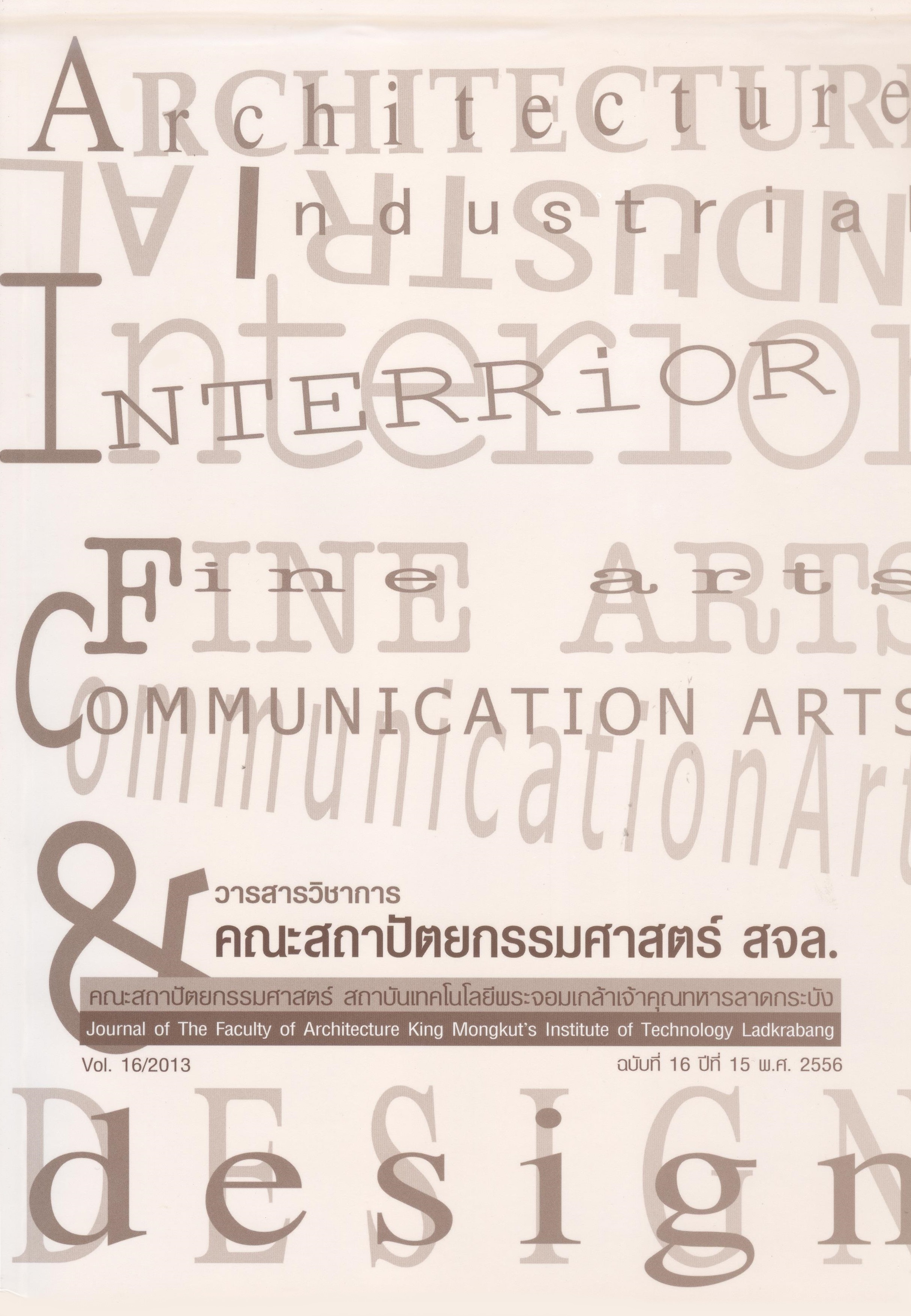ประสบการณ์การเรียนรู้จากกระบวนการอนุรักษ์สถาปัตยกรรมอย่างมีส่วนร่วม: กรณีศึกษาชุมชนริมน้ำจันทบูร (Lesson Learn from Participatory Process in Community Preservation and Restoration: Chanthaboon Waterfront Community Case Study)
Main Article Content
Abstract
บทคัดย่อ
ในประเทศไทยมีการสำรวจพบว่ามีชุมชนเก่าอยู่เป็นจำนวนมาก ซึ่งในชุมชนเหล่านั้น มีอาคารบ้านเรือนในแต่ละชุมชนที่เป็นสิ่งสะท้อนความเป็นมา วัฒนธรรมในแต่ละพื้นที่แต่อาคารเก่านั้นยังไม่ได้รับการดูแลรักษาอย่างถูกต้องและต่อเนื่องทำให้เกิดความทรุดโทรมไปตามกาลเวลา จึงเกิดคำถามว่า เจ้าของหรือผู้อยู่อาศัยภายในอาคารเก่า มีความสำคัญและจะมีการมีส่วนร่วมอย่างไรในกระบวนการอนุรักษ์สถาปัตยกรรม จึงนำไปสู่วัตถุประสงค์ของการวิจัย ในการศึกษาแนวทางการอนุรักษ์และปรับปรุงสถาปัตยกรรม โดยการสร้างการมีส่วนร่วมกับเจ้าของอาคารหรือผู้อยู่อาศัย โดยศึกษาปัจจัยที่เอื้อให้เกิดการมีส่วนร่วมในกระบวนการอนุรักษ์ปรับปรุงสถาปัตยกรรม รวมถึงข้อจำกัดต่างๆ ที่เป็นอุปสรรคในการทำกระบวนการอนุรักษ์และปรับปรุงสถาปัตยกรรม และข้อจำกัดต่างๆ ที่เป็นอุปสรรคในการทำกระบวนการ
วิธีการวิจัยเป็นการวิจัยเชิงคุณภาพในลักษณะการวิจัยเชิงปฏิบัติการอย่างมีส่วนร่วม (Participatory Action Research) โดยเป็นการลงไปทำงานในพื้นที่ร่วมกับกลุ่มอาสาสมัครในชุมชนที่สนใจการฟื้นฟูและอนุรักษ์ชุมชน เพื่อหาแนวทางในการมีส่วนร่วมในกระบวนการอนุรักษ์และปรับปรุงอาคารด้วยวิธีการพูดคุยกลุ่มย่อย การสัมภาษณ์อย่างไม่เป็นทางการ การเก็บข้อมูลรายละเอียดอาคาร การจัดกิจกรรมกระตุ้นจิตสำนึกของการอนุรักษ์ เพื่อเป็นข้อมูลสำหรับการพูดคุยถึงโอกาสในการอนุรักษ์อาคารในชุมชน โดยสร้างโอกาสให้ชาวชุมชนได้เข้ามามีส่วนร่วมในกระบวนการอนุรักษ์ปรับปรุงสถาปัตยกรรม
ผลการวิจัยพบว่าปัจจัยที่เอื้อให้เกิดแนวทางการอนุรักษ์และกระบวนการมีส่วนร่วมนั้น จะต้องมีทั้งความร่วมมือจากเจ้าของอาคารคนในชุมชนเครือข่าย จึงจะสามารถทำให้เกิดการผลักดันกระบวนการอนุรักษ์ปรับปรุงสถาปัตยกรรมในชุมชนได้ แม้ว่าในปัจจุบันยังมีข้อจำกัดของการให้ความร่วมมือของเจ้าของอาคารและความร่วมมือจากคนในท้องถิ่น รวมถึงยังขาดการสนับสนุนจากเครือข่ายต่างๆ แต่สิ่งที่ผลการวิจัยชิ้นนี้พบคือแนวทางตัวอย่างของการปรับปรุงอาคารบ้านเลขที่ 69 ที่เกิดกลุ่มอาสาสมัครที่มีจิตสำนักรักท้องถิ่น มีความเสียสละ ร่วมคิดร่วมทำมีการทำงานร่วมกับเครือข่ายต่างๆ จนเป็นบ้านเรียนรู้ชุมชนที่สามารถถ่ายทอดคุณค่าและความรู้ท้องถิ่นให้กับบุคคลทั่วไป
คำสำคัญ: การอนุรักษ์สถาปัตยกรรม กระบวนการมีส่วนร่วม
Abstract
In Thailand, there are several of historical communities with architectural heritages that represent the history and culture of the area; the historical buildings that have not been maintained properly and consistently causing the deterioration through time. The question arises from the situation that whether the owner or residents within the building will take the important roles in the conservation of these heritages. The question led to the research objective to explore the participatory process with the owner of residents in architecture conservation in terms of causes and constraints.
The method is qualitative Participatory Action Research approach (PAR) with the voluntary groups in community to create the conservation guidelines through the focus group discussions, informal interviews, architectural surveys, and conservation activities.
The results show that factors in participatory process in community preservation and restoration processes that must have the cooperation of the building owners, Community and network. Although at present, there are limits ton the cooperation of the building owners and the participation of local people and the lack of support networks. But what this study found that
Experimental of the at house no.69’s preservation and restoration process. That’s show the community participation can drive the architectural conservation in communi8ty, create the voluntary group with conservation awareness and volunteer spirit, and also the communi8ty conservation center; a part of learning process among community members and public.
Keywords: Preservation Restoration Participatory Process
Article Details
This work is licensed under a Creative Commons Attribution-NonCommercial-ShareAlike 4.0 International License.
Copyright Transfer Statement
The copyright of this article is transferred to Journal of The Faculty of Architecture King Mongkut's Institute of Technology Ladkrabang with effect if and when the article is accepted for publication. The copyright transfer covers the exclusive right to reproduce and distribute the article, including reprints, translations, photographic reproductions, electronic form (offline, online) or any other reproductions of similar nature.
The author warrants that this contribution is original and that he/she has full power to make this grant. The author signs for and accepts responsibility for releasing this material on behalf of any and all co-authors.


